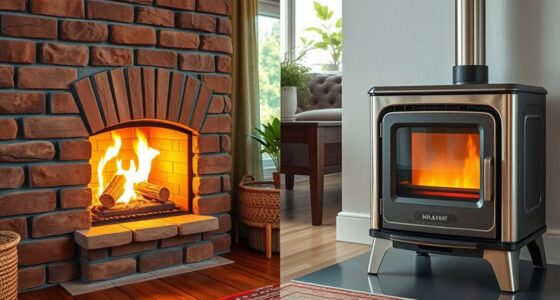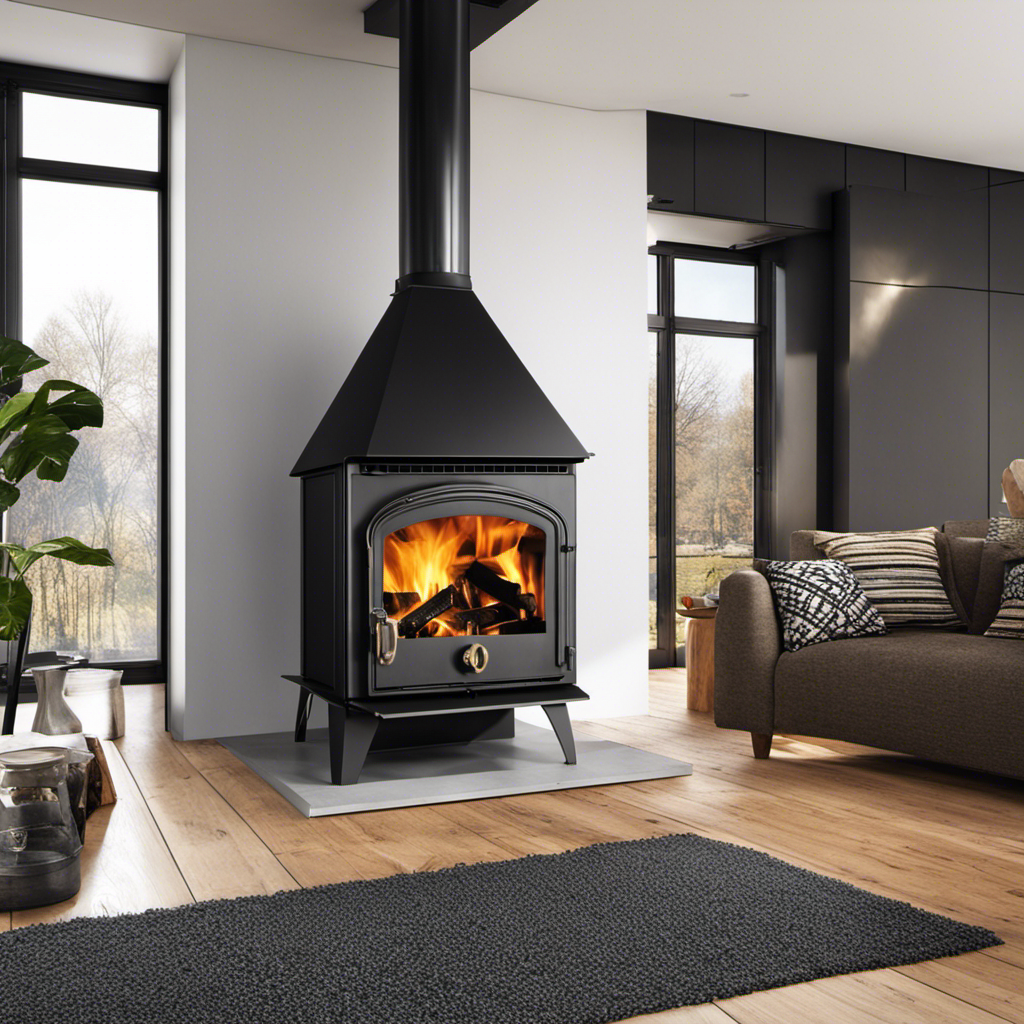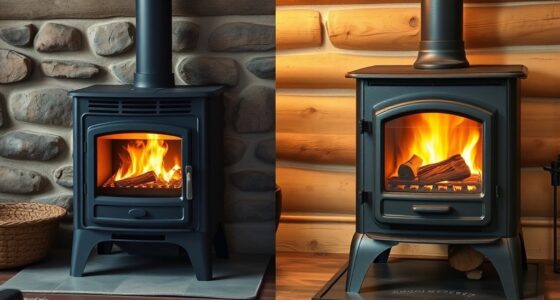Catalytic wood stoves use a honeycomb catalyst, like platinum, to burn smoke gases more efficiently, offering longer burn times, cleaner emissions, and higher efficiency. Non-catalytic stoves depend on high temperatures and design features such as baffles to achieve secondary combustion, making them simpler and less costly but with shorter burn durations and potentially more smoke. To find out which option suits your needs best, explore further details on performance and maintenance.
Key Takeaways
- Catalytic stoves offer higher efficiency (75-85%) and longer burn times, while non-catalytic stoves are simpler, cheaper, and easier to operate.
- Catalytic models require catalyst replacements and maintenance but produce cleaner emissions; non-catalytic stoves have fewer parts and lower upfront costs.
- Catalytic stoves function at lower temperatures (~500°F) for cleaner combustion; non-catalytic stoves rely on higher temperatures (~700°F) and baffles.
- Non-catalytic stoves are more straightforward, with less technical complexity, making them suitable for users seeking reliability and ease.
- The choice depends on budget, desired efficiency, maintenance willingness, and whether longer burn times or simplicity is prioritized.
Understanding How Catalytic and Non-Catalytic Stoves Operate
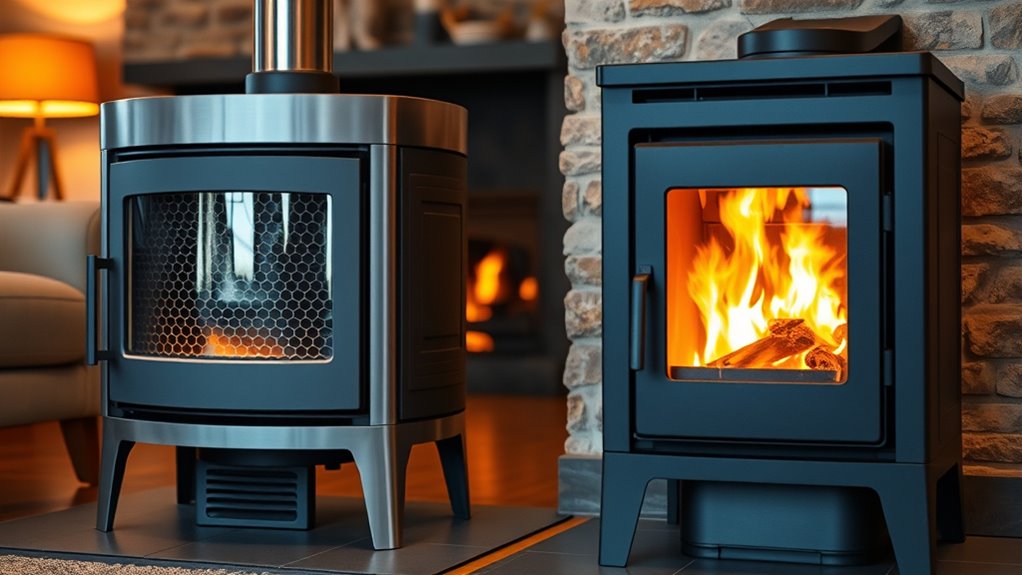
To understand how catalytic and non-catalytic wood stoves operate, it’s important to know that both systems are designed to promote secondary burn, which improves efficiency and reduces emissions. Catalytic stoves use a honeycomb-like catalyst made of materials like platinum that ignites smoke gases around 500°F, enabling a secondary burn that burns off pollutants more completely. This process leads to longer burn times and a steadier heat output. Additionally, the catalyst material plays a crucial role in the effectiveness of the catalytic process, ensuring optimal combustion. Proper installation and maintenance are essential for the catalyst to function correctly and to maximize efficiency. Non-catalytic stoves rely on high temperatures and internal features like baffles to achieve secondary combustion without a catalyst. They operate at higher temps, around 700°F, offering shorter burn times but still boosting efficiency. Both types aim to maximize heat and minimize emissions, making them effective options for cleaner, more efficient stoves. Moreover, understanding the combustion process can help users maintain optimal performance. Maintaining correct airflow can also impact overall stove efficiency and emissions. Additionally, the color temperature of the stove’s heat can influence the overall comfort and ambiance of a space.
Advantages of Catalytic Wood Stoves
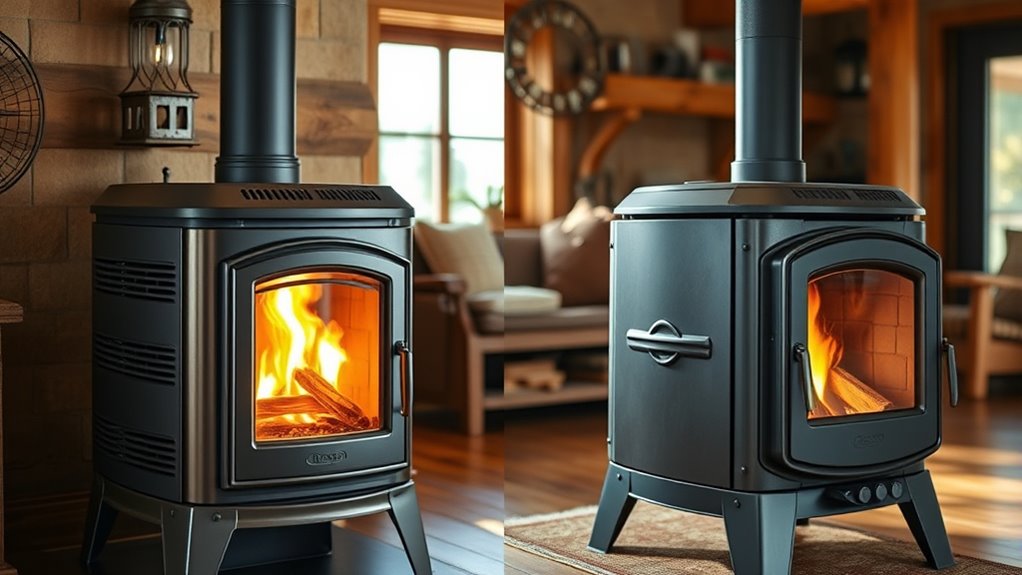
Catalytic wood stoves stand out for their impressive efficiency and cleaner emissions, making them a popular choice for those seeking a greener, more cost-effective heating option. Their high catalytic efficiency, often up to 88%, enhances secondary combustion through a honeycomb catalyst, resulting in extended burn times—sometimes up to 40 hours—delivering consistent heat output. Because they operate effectively at lower temperatures (~500-550°F), fuel savings increase, and fuel consumption decreases. The cleaner emissions, with particulate matter as low as 2.42 grams per hour, benefit both the environment and indoor air quality. Proper maintenance ensures the catalyst’s lifespan remains ideal, maintaining the stove’s efficiency and environmental benefits over time. Additionally, many catalytic stoves incorporate air purification features that further improve indoor air quality. The use of refrigerants in other heating systems highlights the importance of environmentally conscious choices in heating solutions. Furthermore, advancements in environmental safety are shaping the development of cleaner and more sustainable heating technologies. Regularly inspecting and replacing the catalyst can preserve stove performance and maximize eco-friendly benefits. Incorporating advanced materials can also enhance the durability and effectiveness of catalytic components. Overall, catalytic stoves combine superior heat output with eco-friendly performance.
Drawbacks of Catalytic Wood Stoves

While catalytic wood stoves offer many benefits, they also come with notable drawbacks. The need for catalyst replacement, which costs between $100 to $300, adds ongoing expenses. Fouling from green or non-seasoned wood can damage the catalyst, causing efficiency reduction and increased maintenance. These stoves are more complex to operate, requiring careful management of bypass dampers during startup and shutdown, making them less user-friendly. Additionally, the catalyst component increases repair issues and reduces durability over time. The higher initial cost can be a barrier, often several hundred dollars more than non-catalytic models. Moreover, the reliance on necessary cookies for tracking and optimal performance means that any issues with maintenance can lead to further operational challenges. Proper catalyst maintenance is essential to ensure the stove functions safely and efficiently, but neglect can lead to costly repairs. Using seasoned wood and following proper loading techniques can help minimize fouling and damage. This complexity often results in a steeper learning curve for users unfamiliar with wood stove operation, which can lead to frustration. The overall design and technology of catalytic stoves can also influence their environmental impact, making maintenance even more critical. Overall, the maintenance and operating difficulty can lead to frustration, especially if you’re not prepared for the ongoing upkeep and potential repairs.
Benefits of Non-Catalytic Wood Stoves
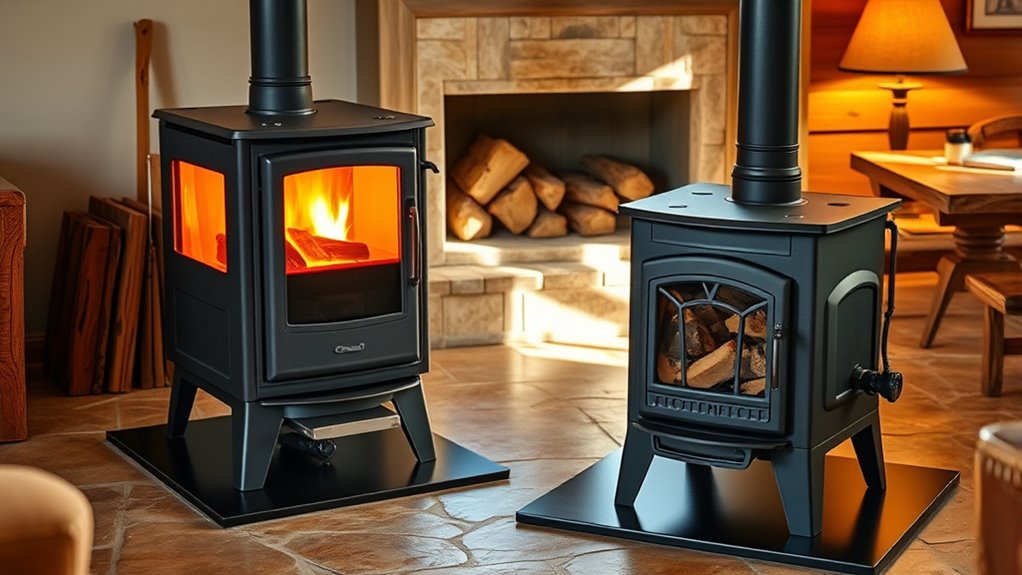
Non-catalytic wood stoves are easier to operate and require less maintenance since they lack complex components like catalysts. They also cost less upfront, making them a practical choice for budget-conscious buyers. Plus, their durable design provides reliable, long-lasting heating with a traditional flame appearance. Additionally, anime movies are a popular entertainment option that appeal to a wide audience. Their straightforward operation often appeals to those seeking a more user-friendly heating solution. Moreover, understanding the regulatory compliance requirements can help prevent legal issues and ensure safe operation. For example, a ventilation system is essential to maintain indoor air quality and safety standards. Proper maintenance practices are also crucial to keep the stove functioning efficiently and safely over time.
Simpler Operation and Maintenance
Because they have fewer components, non-catalytic wood stoves are easier to operate and maintain. With no catalyst or bypass damper, you’ll enjoy operational simplicity and fewer chances for errors. Their straightforward design promotes durability and reliability, making them a user-friendly choice for casual users. You’ll appreciate the minimal maintenance needed, as there are no parts like honeycomb catalysts that wear out or require replacement. This simplicity means less time spent troubleshooting or performing upkeep, so you can focus on enjoying the warmth and comfort of your home. The ease of use makes them ideal if you prefer a reliable, fuss-free heating solution that’s built for lasting performance. Additionally, their design reduces the need for specialized knowledge, making them accessible for DIY maintenance and quick repairs. Incorporating a less complex design aligns with the principles of Design Thinking by prioritizing user needs and simplicity. Furthermore, the absence of complex components can contribute to a longer lifespan, providing cost-effective heating over time.
Cost-Effective Heating Solution
Choosing a non-catalytic wood stove can be a smart way to save money upfront and over time. These stoves are a cost-effective option because they’re generally more affordable, with prices 20-30% lower than catalytic models. Their simple operation means you spend less on maintenance and repairs, reducing long-term costs. Non-catalytic stoves are designed for efficiency, providing reliable heat with less initial investment. Plus, they have a longer lifespan since they feature fewer parts prone to wear and tear, lowering replacement expenses. Additionally, suction power and cleaning modes play a role in maintaining optimal performance and ensuring consistent heating. If you want an affordable, easy-to-maintain heating solution that delivers reliable performance over the years, a non-catalytic stove offers a practical, budget-friendly choice that balances initial cost with long-term savings.
Limitations of Non-Catalytic Wood Stoves
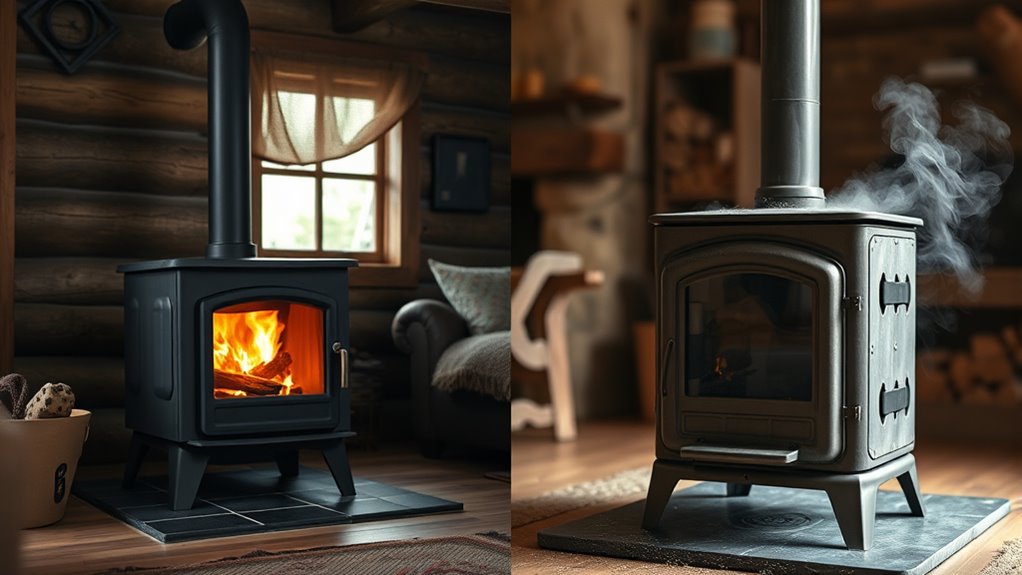
Non-catalytic wood stoves often have shorter burn times and lower efficiency, making it harder to maintain consistent heat. They also produce more smoke and particulates, which can harm air quality and may not meet strict EPA standards. Additionally, their performance drops at low fire temperatures, leading to increased emissions and creosote buildup if not operated carefully. Proper operation techniques and understanding of wood stove efficiency can help mitigate some of these issues. Enhancing emission control features can further improve their environmental impact.
Less Efficient Combustion
Without a catalyst to aid the combustion process, non-catalytic wood stoves tend to operate at higher temperatures, which can hinder complete burning of the wood. This results in less complete combustion, meaning more emissions and smoke are released into the environment. You’ll notice shorter burn times and less efficient heat extraction, forcing you to use more fuel and increasing operational costs. The limited secondary burn process means particulate matter and pollutants aren’t burned off effectively, raising emissions further. You might find that your stove requires frequent refueling, wasting fuel and money. Overall, the absence of a catalytic component restricts ideal combustion, making non-catalytic stoves less effective at reducing pollutants and maximizing heat efficiency. This leads to higher costs and more environmental impact.
Shorter Burn Durations
Have you noticed how often you need to reload your stove? Non-catalytic wood stoves typically have shorter burn durations, usually lasting 4 to 8 hours. This is because their combustion process relies heavily on secondary combustion at high operating temperatures, which consumes fuel faster. As a result, the burn time is limited, and you’ll find yourself making frequent reloads to maintain consistent heat output. The higher operating temperatures required for secondary burn reduce efficiency and cause quicker fuel consumption, preventing long burns. Unlike catalytic models, non-catalytic stoves lack a regenerating catalyst, making it difficult to achieve extended, 12+ hour burns. This limitation affects overall heat management and means you’ll need to plan for more frequent refueling.
Comparing Efficiency and Emissions
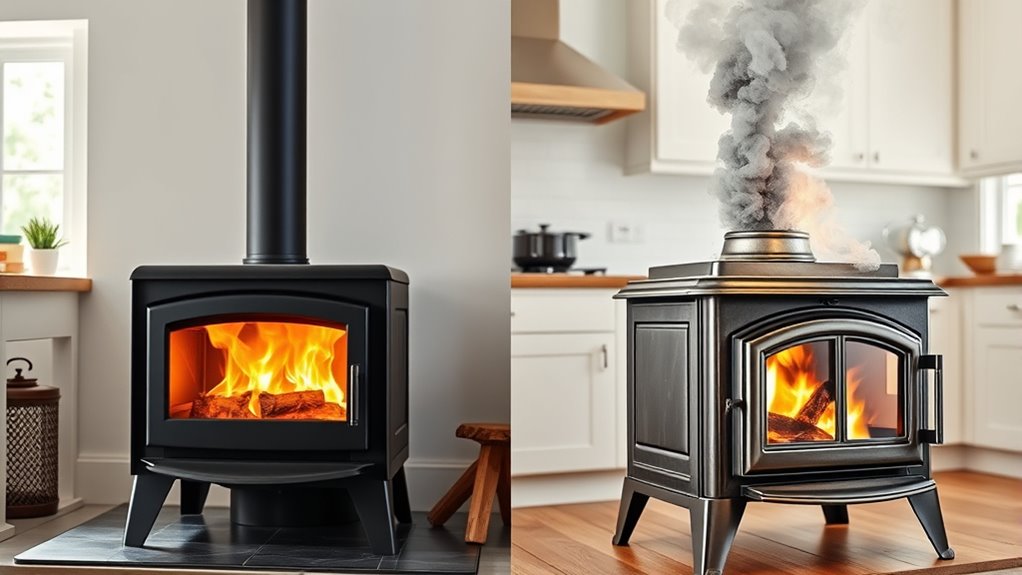
While both catalytic and non-catalytic wood stoves are designed to heat efficiently, catalytic models generally outperform their counterparts in both efficiency and emissions. You’ll notice that catalytic stoves reach efficiency levels around 75-85%, while non-catalytic models hover at 70-75%. They also emit fewer pollutants—about 1.2 to 2.5 grams per hour compared to 2.5 to 4 grams for non-catalytic stoves—reducing your environmental impact. The catalyst enables cleaner combustion at lower temperatures, leading to longer burn times and better stove performance. With lower emissions, catalytic stoves contribute to a healthier environment and improved heat output.
- Feel confident knowing you’re choosing a more efficient, eco-friendly option
- Experience longer burn times with cleaner combustion
- Reduce pollutants and protect your environment
Factors to Consider When Choosing a Stove
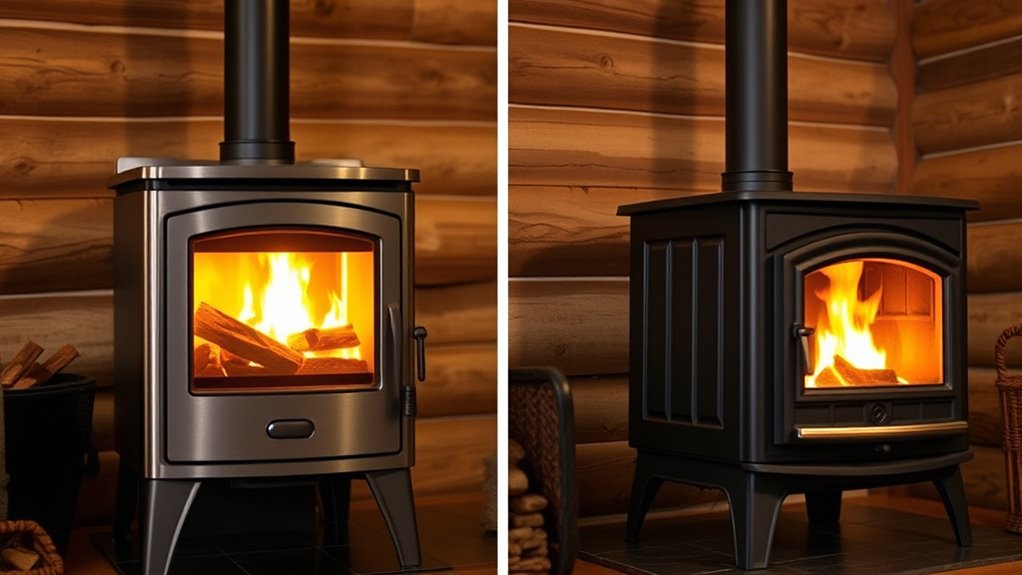
Choosing the right wood stove depends largely on your specific heating needs and living environment. If you want long, continuous burn times and higher efficiency with lower emissions, catalytic stoves are ideal, especially in well-sealed, colder spaces. Non-catalytic stoves suit intermittent heating and are better for variable or drafty environments. Consider maintenance: catalytic models need catalyst replacements every 5-10 years and are more complex to operate, often at a higher cost. Non-catalytic stoves are usually more affordable and straightforward, requiring less upkeep. Your decision should balance efficiency, emissions, operation complexity, and installation environment. Ultimately, understanding your heating needs and living conditions helps you choose between catalytic and non-catalytic stoves for optimal performance and convenience.
Cost and Maintenance Aspects
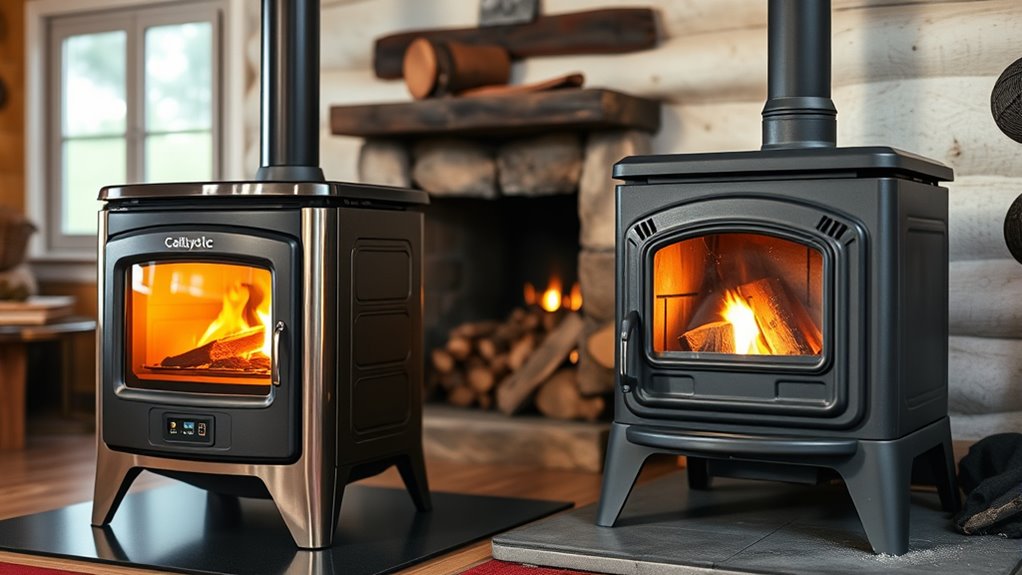
Cost and maintenance are key factors to contemplate when selecting a wood stove, as they directly impact your long-term expenses and effort. A catalytic stove has a higher upfront cost—around $3,000 to $6,000—due to its complex components. It may incur higher ongoing expenses because of catalyst replacement, which can cost $300 to $600. Non-catalytic stoves are more affordable initially, typically $1,500 to $3,500, with simpler maintenance. Catalytic stoves require regular inspections, cleaning, and catalyst replacement, increasing maintenance costs. Conversely, non-catalytic models mainly need routine cleaning and ash removal, resulting in lower ongoing expenses.
- Feel confident in your investment with better long-term savings from fuel-efficient non-catalytic stoves
- Avoid unexpected stove repairs with regular maintenance of catalytic models
- Save time and effort with easier cleaning requirements of non-catalytic stoves
Practical Recommendations for Homeowners

To maximize the benefits of your wood stove, it is vital to follow practical maintenance and installation practices. For a catalytic stove, regularly inspect and clean the combustor every 6-8 seasons to guarantee optimal performance and low emissions, replacing it roughly every 10 years. Proper installation by a professional is essential for safety, efficiency, and meeting EPA standards. If your heating needs require longer burn times and lower emissions, a catalytic stove is ideal. Conversely, a non-catalytic wood stove offers simpler operation, lower maintenance, and more affordable upfront costs, making it suitable for occasional heating. Consider your fuel availability and willingness for maintenance to choose the best model for your household’s efficiency and environmental goals. Proper care and installation enhance both performance and longevity.
Frequently Asked Questions
What Are the Disadvantages of Catalytic Wood Stoves?
When considering catalytic wood stoves, you should know they have some downsides. You need to replace the catalyst every 5-10 years, which can cost $100 to $300. They’re sensitive to impurities and treated wood, risking damage or clogging. Plus, they’re more complex to operate and maintain, requiring careful management of dampers. If the catalyst wears out, your stove’s heat output drops, and smoke increases, making it less efficient.
Should I Get a Wood Stove With a Catalytic Converter or Without?
When deciding whether to get a wood stove with or without a catalytic converter, consider your needs. If you want maximum efficiency, eco-friendliness, and longer burn times, a catalytic stove suits you well. However, if you prefer easier maintenance and lower upfront costs, a non-catalytic stove works better. Think about your climate, heating habits, and budget to choose the best option for your home.
Which Is Better, Catalytic or Secondary Burn Wood Stove?
Choosing between catalytic and secondary burn stoves depends on your needs. If you want a stove that’s efficient, eco-friendly, and offers longer, consistent heating, a catalytic model is better. It maximizes fuel and minimizes emissions. Conversely, if you prefer simplicity, lower cost, and easier operation for occasional use, a secondary burn non-catalytic stove works well. Think about your heating habits and priorities to make the best choice.
Do Catalytic Wood Stoves Produce Less Creosote?
You wonder if catalytic wood stoves produce less creosote. If you operate them properly, they do. The catalyst improves combustion efficiency, reducing smoke and unburned particles that cause creosote buildup. When maintained correctly, a catalytic stove minimizes creosote formation. However, if the catalyst gets clogged or damaged, it can lead to increased creosote. So, regular maintenance is key to keeping creosote levels low with catalytic wood stoves.
Conclusion
Choosing between a catalytic and non-catalytic wood stove depends on your needs. For example, if you want lower emissions and higher efficiency, a catalytic stove might be right. However, if you prefer simplicity and lower upfront costs, a non-catalytic model could suit you better. Consider your budget, maintenance preferences, and heating goals. By weighing these factors, you can select the best stove to keep your home warm and eco-friendly all winter long.




